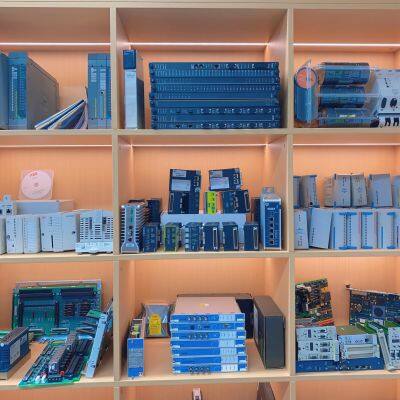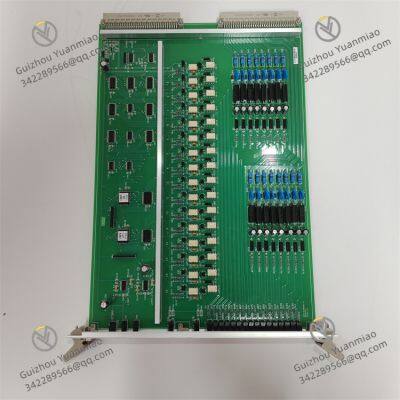Product Description
I. Overview
The ALSTOM VIIB16-C (Model: 12011-105-00 V1.0.0) is a distributed I/O module that must be used in conjunction with the system's main controller (e.g., Alstom GT13E2), on-site sensors (e.g., PT100 temperature sensors, pressure transmitters, flow sensors), actuators (e.g., solenoid valves, servo valves, indicator lights), and safety modules (e.g., STO1726KO1). Its core functions include:
Collecting key equipment parameters (temperature, pressure, flow rate, with a signal range of 4-20mA/0-10V and 16-bit resolution) via 8 analog inputs (AI);
Sending control commands (e.g., valve opening, motor speed, with an accuracy of ±0.1% FS) to actuators through 4 analog outputs (AO);
Monitoring equipment status (e.g., valve on/off, motor operation, fault signals, with a response time of ≤1ms) via 16 digital inputs (DI);
Enabling equipment start/stop control (e.g., pump activation, alarm triggering, with an output current of ≤2A) through 8 digital outputs (DO);
Supporting communication with the main controller via industrial Ethernet (e.g., EtherNet/IP), with a data transmission rate of ≥100Mbps and a delay of ≤10ms;
Incorporating a built-in 32-bit microprocessor that supports signal filtering (adjustable low-pass filter cutoff frequency: 1Hz-100Hz) and fault self-diagnosis (input short circuit/overvoltage, output overload, communication interruption);
Equipped with redundant power inputs, which automatically switch when a single power supply fails, ensuring no power interruption;
Supporting parameter configuration (e.g., signal range, DI anti-jitter time) and status monitoring via Alstom Harmony software;
Adopting a compact design, suitable for installation in industrial control cabinets or on-site distributed installation scenarios.

Its core advantages lie in "multi-type I/O compatibility (full coverage of AI/AO/DI/DO), low-latency communication (≤10ms), wide temperature adaptability (-25℃~70℃), and high anti-interference capability". It is a core component of Alstom's power equipment control system for implementing distributed signal acquisition and control, and is widely used in scenarios such as gas turbine auxiliary control, steam turbine auxiliary systems, and large-scale compressor condition monitoring.
In the auxiliary control of the GT13E2 gas turbine, the VIIB16-C collects the bearing temperatures of 4 auxiliary machines (PT100 signals), 2 lubricating oil pressure signals (4-20mA), and 2 cooling water flow rate signals (0-10V) via 8 AI channels; monitors the operating status of 8 auxiliary motors and 8 valve on/off feedback signals via 16 DI channels; controls the speed of 2 lubricating oil pumps and the air speed of 2 cooling fans via 4 AO channels; and triggers 4 auxiliary fault alarms and 4 emergency shutdown signals via 8 DO channels. It communicates with the main controller via EtherNet/IP, with a data transmission delay of ≤8ms. The control error of the auxiliary bearing temperature is reduced from ±1.5℃ to ±0.5℃, preventing bearing damage due to overheating. In the steam turbine auxiliary system of a coal-fired power plant, the module adopts a redundant power supply design (dual 24V DC inputs). When the main power supply fails, it switches to the backup power supply within 0.5ms, ensuring uninterrupted auxiliary control and avoiding interruptions in steam turbine lubricating oil supply (a single interruption may cause unit shutdown, resulting in losses exceeding 1 million yuan). In the condition monitoring of a large compressor in a petrochemical enterprise, the module withstands an alternating environment of -20℃ low temperature and 65℃ high temperature, operating continuously for 365 days without faults, with a Mean Time Between Failures (MTBF) of ≥80,000 hours, meeting the "7×24-hour uninterrupted production" requirement of the petrochemical industry. In the auxiliary steam system of a nuclear power plant, the module adopts a strong electromagnetic shielding design (metal housing + photoelectric isolation). Near 10kV frequency converters (with electromagnetic radiation of 50V/m), the signal-to-noise ratio of AI-collected signals is ≥85dB, eliminating false data caused by interference (e.g., pressure fluctuations) and ensuring accurate steam parameter monitoring.
In terms of hardware design, the module adopts an "all-type I/O integration + distributed communication" architecture:
I/O Channels and Signal Processing: It has 8 AI channels (4 for 4-20mA, 4 for 0-10V, 16-bit resolution, accuracy ±0.05% FS, sampling rate 1kHz per channel), supporting PT100 platinum resistance input (2 additional RTD channels, accuracy ±0.1℃); 4 AO channels (2 for 4-20mA, 2 for 0-10V, 16-bit resolution, accuracy ±0.1% FS, output load ≤500Ω for current signals/≥1kΩ for voltage signals); 16 DI channels (24V DC dry contacts, high level ≥18V, low level ≤5V, response time ≤1ms, supporting edge detection and adjustable anti-jitter filtering (0.1ms-10ms)); 8 DO channels (24V DC open collector, output current ≤2A, response time ≤100μs, equipped with overload protection (short-circuit current ≤5A)). All I/O channels are equipped with photoelectric isolation (isolation voltage ≥2kVrms) and electromagnetic shielding (metal housing + double-layer shielded wires) to avoid on-site electromagnetic interference (e.g., from motors and frequency converters). Input channels have overvoltage protection (maximum input 30V DC) and short-circuit protection (response time ≤5μs).
Core Communication and Control Unit: It incorporates a built-in 32-bit ARM Cortex-M4 MCU (operating rate 168MHz), supporting EtherNet/IP industrial Ethernet communication (100Mbps rate, full-duplex) and compatible with the Modbus TCP protocol (optional). It is equipped with 64MB Flash (for storing configuration parameters and firmware) and 32MB RAM (for caching real-time I/O data), supporting online firmware upgrades (without interrupting I/O communication). It supports collaboration with safety modules (e.g., STO1726KO1) to realize the linkage between I/O signals and safety trip logic.
Housing and Protection: It uses a die-cast aluminum alloy housing (with anti-corrosion coating, thickness ≥1.5mm) with dimensions of 160mm×120mm×50mm (length × width × height), supporting DIN rail mounting (35mm standard rail) and panel mounting. It has an IP20 protection rating (dust-proof and finger-touch proof), suitable for industrial control cabinet environments. The operating temperature range is -25℃~70℃, the storage temperature range is -40℃~85℃, and the relative humidity range is 5%~95% (non-condensing). It has vibration resistance (compliant with IEC 60068-2-6 standard: 10-500Hz, 1g acceleration) and shock resistance (compliant with IEC 60068-2-27 standard: 15g acceleration, 11ms pulse width), making it suitable for the vibration environment of power equipment.
Safety and Redundancy Design: It supports dual redundant power inputs (24V DC±20%, compatible with 12V DC/48V DC), which automatically switch when a single power supply fails, with a switching time of ≤0.5ms and no power interruption. Key circuits (MCU, power supply, communication interface) adopt anti-interference design to avoid I/O communication interruption caused by single-point faults. It complies with the EN 61000-6-2 electromagnetic compatibility standard and UL 508 industrial safety standard, meeting the safety operation requirements of power equipment.

II. Technical Parameters
1. I/O Channels and Signal Parameters
2. Communication and Control Performance Parameters

3. Environmental and Reliability Parameters
III. Functional Features
1. Full-Type I/O Integration for Multi-Parameter Monitoring and Control
With "full coverage of AI/AO/DI/DO+RTD" as its core, the VIIB16-C addresses the pain points of traditional I/O modules, such as "single function and requirement for multiple module stacking":
Centralized Management of 4 Types of Signals: A single module integrates 8 AI channels (including RTD), 4 AO channels, 16 DI channels, and 8 DO channels, covering all types of signals (temperature, pressure, flow rate, status, control) for power equipment. In a gas turbine auxiliary system, 2 I/OBE2 modules replace 6 traditional single-function modules, reducing the control cabinet space occupancy by 70%.
Accurate Temperature Measurement via RTD: 2 additional PT100 inputs (accuracy ±0.1℃) enable direct collection of temperatures at key locations such as bearings and windings without external temperature transmitters. In a steam turbine system, the temperature collection error is reduced from ±0.8℃ to ±0.1℃, enabling early warning of bearing overheating 1 hour in advance.
AO Output Value Retention: AO channels maintain the last output state (e.g., valve opening) when power is off, avoiding misoperation of actuators. After a power-off recovery in a petrochemical compressor system, the valves do not require recalibration and can resume operation quickly (traditional modules require 30 minutes of recalibration).

2. Low-Latency Distributed Communication for Real-Time Control
To meet the "real-time transmission of I/O signals" requirement of power equipment, the module ensures timely data interaction through communication optimization:
100Mbps Ethernet Communication: Full-duplex transmission via EtherNet/IP, with a delay of ≤10ms from I/O data collection to transmission to the controller. In a gas turbine auxiliary system, the response time of the speed control command is reduced from 25ms to 8ms, and the speed fluctuation is reduced from ±5rpm to ±2rpm.
Data Frame Optimization: Supports large-frame transmission of 512 bytes, reducing the number of communication frames (e.g., 16 DI signals can be transmitted in 1 frame). In a steam turbine auxiliary system, the number of communication frames is reduced from 20 frames/second to 5 frames/second, lowering the controller load by 60%.
Protocol Compatibility: The optional Modbus TCP protocol is compatible with third-party control systems (e.g., a power plant connects the VIIB16-C to the ABB 800xA DCS without additional gateways, reducing integration costs by 40%).
ALSTOM CMP1838 TRVCO62345000 CP00005202 Control Module
ALSTOM DSI1817 TRVC062335000 CP00003934 Digital Control Module
ALSTOM POS1846 TRVC062333000 CP00000310 Power Distribution Module
ALSTOM VPS 12004-102-03 V1.0.0 Input/Output Module
ALSTOM VOOB8-B 12004-106-04 VER:V1.0.0 Electronic Output Module
AMAT 0010-23716 RTP pyrometer


DEIF PSM-1 Power Supply Module
DEIF CM-2 Control Module
DEIF IPM-1 Intelligent Power Manager
ABB PM645B 3BSE010535R1 Processor Module
ABB PPD513A-23-111615 magnetic excitation controller
TRICONEX Safety Instrumented System (SIS) 4351B control module
Bentley Nevada 3500/22M Transient data interface module
Bently Nevada 3500/15-05-05-00 power module
Triconex 3009 processor module
ABB GFD563A102 3BHE046836R0102 Excitation Convection Interface Module
ABB PPD117A3011 3BHE030410R3011 Excitation Controller
ABB PCD231B101 3BHE025541R0101 Excitation Unit Controller
 yezi
Hi there! Welcome to my shop. Let me know if you have any questions.
yezi
Hi there! Welcome to my shop. Let me know if you have any questions.






